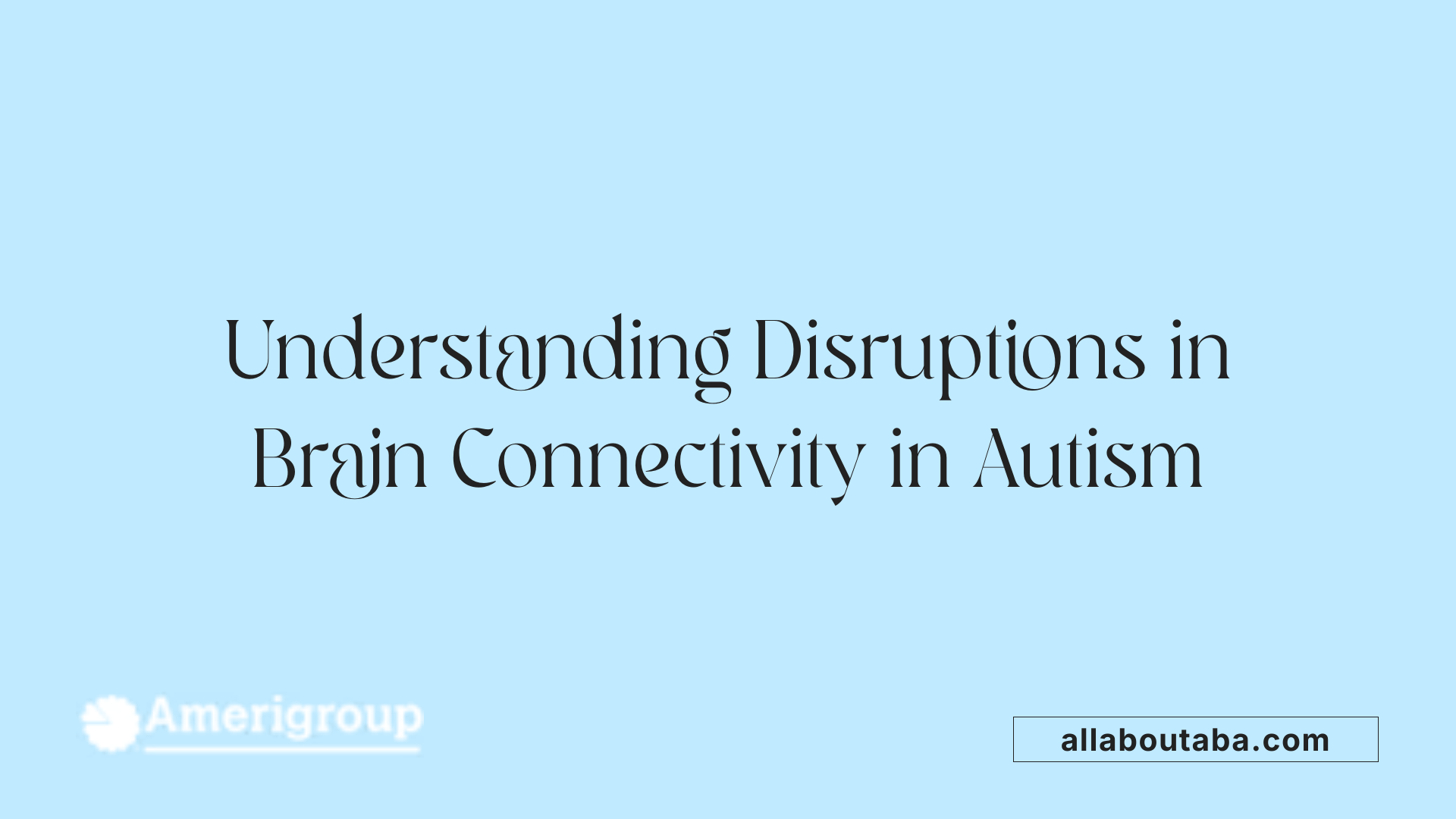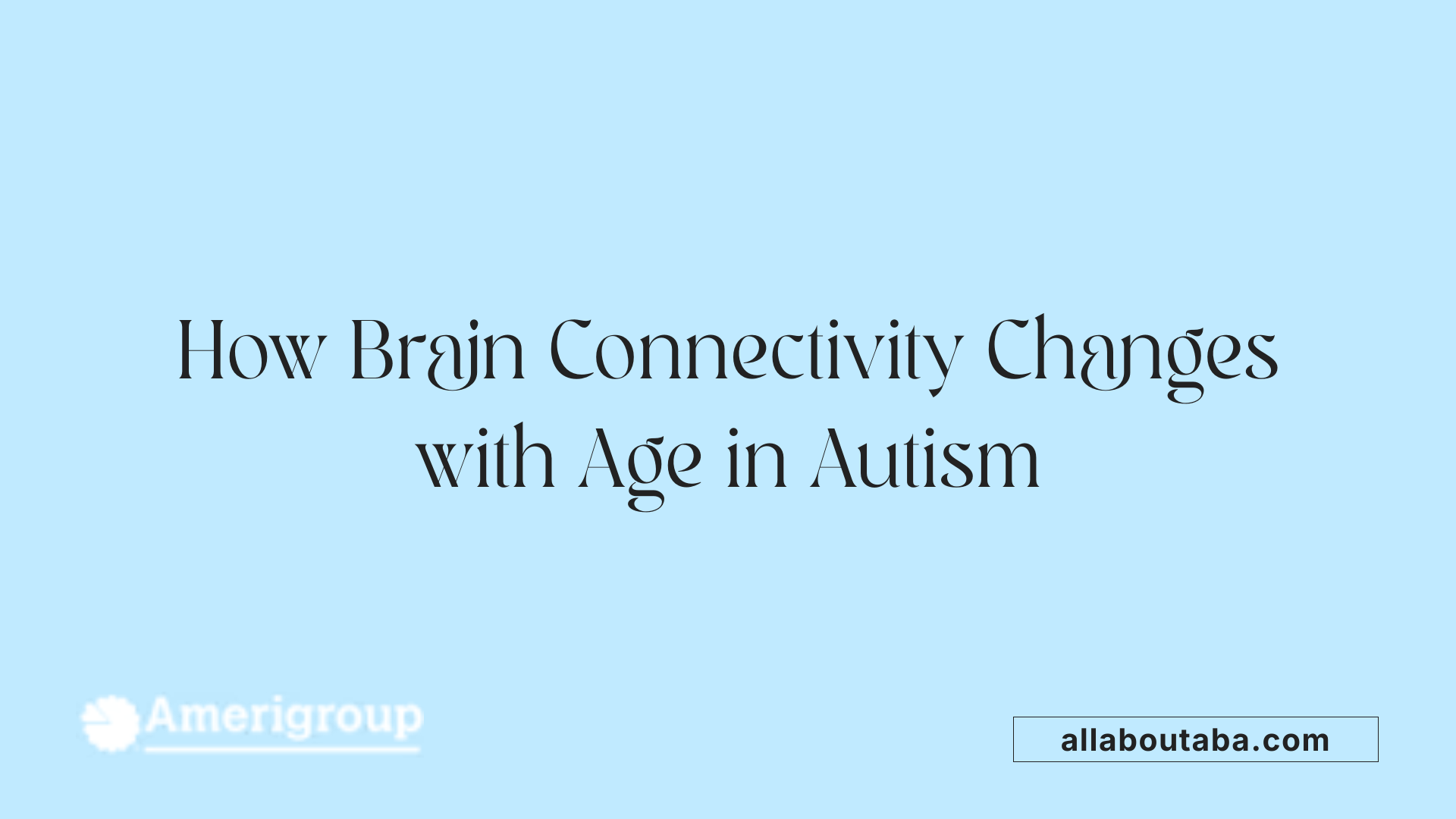The Science Of Brain Connectivity In Autism
Understanding Autism Through the Lens of Brain Connectivity
Autism Spectrum Disorder (ASD) presents a complex interplay of behavioral and neurological traits, with emerging research emphasizing the critical role of brain connectivity in shaping its manifestations. This narrative delves into the science behind altered brain networks in autism and explores how these insights are revolutionizing behavioral therapies and interventions today.
Foundations of Brain Connectivity in Autism

What disruptions in brain connectivity are observed in autism spectrum disorder?
Research shows that autism spectrum disorder (ASD) involves significant disruptions in both functional and structural brain connectivity. Functional connectivity MRI (fcMRI) studies reveal altered synchronization of brain activity, with patterns of hypo-connectivity (reduced connection) in some regions and hyper-connectivity (increased connection) in others. These abnormalities are linked with behavioral features of ASD.
What neuroimaging findings highlight these connectivity changes?
Neuroimaging techniques including fcMRI, diffusion tensor imaging (DTI), and graph theory analyses reveal important insights. Adolescents with ASD often show increased connectivity particularly between the right lateral parietal region and prefrontal areas, while younger children tend to exhibit widespread hyper-connectivity that may shift to hypo-connectivity with age. Diffusion MRI also identifies compromised white matter tracts, such as those connecting the cerebellar cortex and dentate nuclei, which align with postmortem findings like Purkinje cell loss.
How do connectivity abnormalities vary by brain region?
Connectivity alterations in ASD are region-specific. Local overconnectivity is commonly found in the posterior occipital and temporal cortices, areas responsible for visual and auditory processing. Conversely, underconnectivity is often observed in the posterior cingulate and medial prefrontal cortex, regions involved in self-referential thought and social cognition. This complex pattern suggests that autism involves both excessive and deficient neural communication across different brain networks.
Hypo- and Hyperconnectivity Patterns in Autism

What does functional connectivity MRI reveal about autism?
Functional connectivity MRI (fcMRI) is a powerful tool that measures correlations in brain activity by detecting blood oxygen level dependent (BOLD) signals. In individuals with autism spectrum disorder (ASD), fcMRI studies reveal patterns of both hypo- and hyperconnectivity in the brain. These results indicate that the autistic brain does not communicate uniformly across regions but rather shows complex connectivity differences.
How do local and long-range connectivities differ in ASD?
Research indicates a distinctive pattern where local overconnectivity is observed, particularly in posterior occipital and temporal cortices. Conversely, decreased or underconnectivity is found in regions that facilitate long-range communication, such as the posterior cingulate and medial prefrontal areas. This suggests that while some areas of the brain may be excessively interconnected, others suffer from weakened links, which could underlie the varied symptoms seen in autism.
What does graph theory tell us about connectivity in adolescents with ASD?
Graph theory applied to fcMRI data in adolescents with ASD has uncovered increased connectivity between specific brain areas. For example, enhanced connectivity has been reported between the right lateral parietal cortex and several prefrontal regions. This finding supports the idea that autism involves complex regional connectivity alterations that may contribute to its cognitive and behavioral traits.
Overall, fcMRI and graph theoretical approaches reinforce that autism is associated with a nuanced combination of increased local connectivity and reduced long-range communication across brain networks. These intricate connectivity patterns offer insight into the neural basis of ASD and suggest avenues for targeted interventions.
Developmental Trajectories of Brain Connectivity in ASD

How does brain connectivity shift with age in individuals with ASD?
Research reveals that brain connectivity in autism spectrum disorder (ASD) changes notably across development. Younger children with ASD tend to display hyper-connectivity, meaning increased connections among certain brain regions. However, as individuals age, particularly moving into adolescence and adulthood, there is often a shift toward hypo-connectivity, or reduced connectivity between some areas. This shift highlights that connectivity abnormalities are not static but evolve over time.
Why is a lifespan perspective important for understanding ASD connectivity?
A lifespan perspective is crucial because brain connectivity patterns differ at various developmental stages in ASD. Early hyper-connectivity during childhood might contribute to excessive local processing or overstimulation, whereas later hypo-connectivity could relate to difficulties in integrating information across distant brain regions. Recognizing these temporal changes allows for a more nuanced understanding of ASD's neural underpinnings and may inform age-specific interventions.
What connectivity changes occur during childhood and adolescence in ASD?
Studies using functional connectivity MRI and graph theory demonstrate that adolescents with ASD show increased connectivity particularly between the right lateral parietal cortex and prefrontal regions. This pattern differs from younger children, where hyper-connectivity tends to be more widespread and local, especially in posterior occipital and temporal cortices. As development progresses, some connectivity patterns weaken, suggesting a dynamic reorganization continuing into adolescence and beyond.
Together, these findings underscore the importance of monitoring connectivity changes throughout development to better discern typical versus atypical neural trajectories in ASD.
Multimodal Neuroimaging Insights into Autism

What has diffusion tensor imaging revealed about white matter in autism?
Diffusion tensor imaging (DTI) studies have illuminated critical abnormalities in white matter integrity among individuals with autism spectrum disorder (ASD). These findings suggest disruptions in the microstructural organization of neural pathways, which are vital for efficient communication between brain regions. Such disruptions likely contribute to the altered connectivity patterns observed in ASD.
How are cortical folding abnormalities related to connectivity deficits?
Abnormalities in cortical folding have emerged as a notable feature in ASD brains. These deviations may affect cortical surface area and thickness, impacting neuronal connectivity. Altered folding patterns can influence how cortical regions interact, potentially underpinning the local overconnectivity and long-range underconnectivity seen in autism.
What has diffusion MRI revealed about cerebellar connectivity?
Diffusion MRI studies have identified compromised white matter tracts linking the cerebellar cortex and dentate nuclei in ASD individuals. This is consistent with neuropathological evidence from postmortem studies reporting Purkinje cell loss in the cerebellum. These cerebellar abnormalities may disrupt both motor and cognitive circuits, reflecting the cerebellum's role beyond coordination.
How does multimodal imaging enhance our understanding of autism?
By combining DTI with functional and structural imaging, researchers gain a comprehensive view of brain connectivity disruptions in ASD. This multimodal approach allows correlation of white matter integrity with cortical morphology and functional alterations, providing a richer understanding of the neural basis of autism.
| Imaging Method | Findings in ASD | Implications |
|---|---|---|
| Diffusion Tensor Imaging (DTI) | Reduced white matter integrity, disrupted microstructure | Affects neural communication pathways, underlying connectivity differences |
| Cortical Folding Analysis | Abnormal folding patterns, altered cortical surface | Influences the interaction among cortical regions, relates to connectivity alterations |
| Diffusion MRI of Cerebellar Tracts | Compromised tracts between cerebellar cortex and dentate nuclei | Reflects Purkinje cell loss, impacts motor and cognitive functions |
Multimodal neuroimaging continues to be instrumental for mapping the complex brain network alterations in ASD, paving the way for improved biomarkers and targeted therapies.
Cellular and Structural Contributors to Connectivity Alterations

What postmortem findings support connectivity changes in autism?
Postmortem brain studies in individuals with autism spectrum disorder (ASD) reveal critical cellular abnormalities linked to connectivity disruptions. One notable finding is the loss of Purkinje cells in the cerebellum, a pattern consistent with diffusion MRI evidence showing compromised white matter tracts between the cerebellar cortex and dentate nuclei. These cerebellar changes may contribute to both motor and cognitive impairments frequently observed in ASD.
How do excess interstitial neurons and axonal pathologies affect brain connectivity?
Research has identified an excess of interstitial neurons in the white matter and various axonal pathologies in autistic brains, which likely interfere with the normal wiring and communication among brain regions. Such cellular irregularities pose hurdles for effective synaptic transmission and may underlie the atypical patterns of both local overconnectivity and long-range underconnectivity seen in ASD.
What genetic factors influence connectivity abnormalities in autism?
Genetic studies highlight syndromes like fragile X, sharing phenotypic features with ASD, where synaptic structures show increased density of immature dendritic spines. This reflects disrupted synaptic maturation and connectivity. The high concordance rate among identical twins further corroborates a strong genetic component driving the neurodevelopmental deviations in connectivity.
How do immunological processes contribute to connectivity differences?
Proteins from the major histocompatibility complex (MHC), expressed on neurons, are important in synaptic pruning and plasticity. Altered MHC expression, potentially triggered by maternal viral infections during pregnancy, represents an environmental-immunological risk factor. These mechanisms suggest a link between immune system dysfunction and atypical neural connectivity observed in ASD.
| Aspect | Observation | Implication for Brain Connectivity |
|---|---|---|
| Purkinje Cell Loss | Reduced numbers in autism cerebellum | May disrupt motor-cognitive circuit function |
| Excess Interstitial Neurons | Increased density in white matter | Potential interference with synaptic transmission and axonal guidance |
| Axonal Pathologies | Structural abnormalities in axons | Hinders effective long-range connectivity |
| Genetic Influences | Fragile X syndrome and hereditary factors | Impaired synaptic maturation and connectivity |
| Immunological Factors | MHC protein involvement and maternal infection | Impacts synaptic pruning and plasticity |
Functional Abnormalities Linked to Cerebellar Dysfunction
What is cerebellar hypoplasia and its role in autism?
Cerebellar hypoplasia in autism refers to the underdevelopment or reduced size of the cerebellar vermis, a key region within the cerebellum. MRI and autopsy studies have consistently shown this structural abnormality in individuals with autism spectrum disorder (ASD). This reduction impacts cognitive and motor functions, areas where children with autism often struggle.
How are Purkinje cell numbers altered in autism?
A hallmark finding in ASD neuropathology is impaired Purkinje cell numbers. Purkinje cells are critical neurons within the cerebellar cortex responsible for modulating motor coordination and cognitive processing. Postmortem studies reveal a significant loss of these cells in the cerebellar cortex of autistic individuals, likely contributing to disrupted cerebellar output and functionality.
What distinctive cerebellar activation patterns characterize autism?
Functional imaging reveals abnormal cerebellar activation patterns during different tasks in autism. Specifically, individuals with ASD show low cerebellar activation during attention-demanding tasks and unusually high activation during motor tasks. These opposing activation profiles reflect functional impairments linked to the observed structural deficits, highlighting the cerebellum's multifaceted role in autism-related behaviors and symptoms.
These cerebellar abnormalities—structural hypoplasia, Purkinje cell reduction, and atypical functional activation—underscore the cerebellum's critical involvement in the neurological basis of autism, influencing both motor and cognitive domains.
Neural Oscillations and Connectivity Disruptions
What are gamma-band oscillations abnormalities in autism?
Gamma-band oscillations, brain rhythms occurring at 30-80 Hz, are essential for neural communication and information processing. In individuals with autism, studies have found abnormalities in these oscillations, suggesting disrupted neural synchrony. These atypical gamma rhythms reflect irregular timing in neuronal firing, which can impair the coordination of brain networks.
How do neural synchrony impairments affect autism?
Neural synchrony refers to the simultaneous, coordinated activity of neurons across brain regions. Autism-related disruptions in gamma-band oscillations signal impaired synchrony, particularly within circuits involved in sensory integration and attention. This impaired synchrony hinders efficient communication among brain areas responsible for higher-order cognitive functions.
What is the impact on attention and feature binding in autism?
Gamma oscillations play a critical role in feature binding—the process by which the brain integrates distinct sensory inputs into a cohesive perception. Abnormal gamma activity in autism can disrupt this integration, leading to difficulties in processing complex stimuli. Moreover, attention-related processes that depend on synchronized neural activity also suffer, contributing to characteristic attentional deficits in autism.
These findings indicate that alterations in gamma oscillations contribute significantly to connectivity disruptions in autism spectrum disorder, affecting key cognitive processes such as attention and perception.
Early Brain Overgrowth and Synaptic Alterations in ASD
What is known about frontal lobe overgrowth in early autism?
Research shows that early brain overgrowth in autism spectrum disorder (ASD) primarily affects the frontal lobes. This overgrowth occurs postnatally within the first 6 to 14 months of life, a critical period for brain development. The frontal lobes, responsible for higher cognitive functions such as decision-making, social behavior, and communication, show a notable increase in size during this time.
How do increased brain volume and white matter manifest in ASD?
Alongside frontal lobe expansion, studies report an overall increase in brain volume and white matter in young children with ASD. This early enlargement contrasts with typical brain growth patterns and is characterized by greater white matter density, which suggests altered neural connectivity pathways. Such atypical development may influence how different brain regions communicate, potentially contributing to ASD symptoms.
What synaptic changes are linked to early brain overgrowth in autism?
The abnormal early brain growth in ASD is related to synaptogenesis and dendritic arborization alterations. Synaptogenesis is the formation of synapses between neurons, while dendritic arborization refers to the branching of dendrites, both crucial for neural network complexity. In ASD, there may be dysregulation in these processes, including excessive synapse formation or immature synaptic structures. This can disrupt neural circuitry and impact information processing.
These synaptic abnormalities might result in inefficient communication among brain circuits, aligning with clinical observations of social, communicative, and behavioral challenges in ASD. Understanding these early neural changes offers insight into the developmental origins of autism and may inform timing for interventions that target neurodevelopmental pathways.
Linking Sleep Disorders and Brain Connectivity in Autism
What is the prevalence of sleep disorders in autism spectrum disorder (ASD)?
Sleep disorders affect a significant proportion of children with ASD, ranging from 40% to 80%. These disorders include delayed sleep onset, frequent night-time awakenings, parasomnias, sleep-disordered breathing, and daytime sleepiness. Moreover, children with both ASD and sleep disorders often exhibit more severe language, social, behavioral, and emotional difficulties compared to those without sleep problems.
What have studies using functional near-infrared spectroscopy (fNIRS) revealed about brain connectivity in ASD with sleep disorders?
Functional near-infrared spectroscopy (fNIRS) is a safe, non-invasive method for measuring changes in blood oxygenation and volume that reflect neuronal activity and connectivity. Recent studies comparing children with ASD who have sleep disorders, those without sleep disorders, and typically developing peers have found decreased functional connectivity (FC) in several brain regions among the ASD with sleep disorders group. Specifically, reduced connectivity was observed in the supramarginal gyrus, inferior frontal gyrus, frontopolar area, dorsolateral prefrontal cortex (DLPFC), and visual association cortex. Generally, both ASD groups showed weaker FC than typically developing children, with the ASD and sleep disorder group showing the most pronounced weakening.
How are sleep disturbances linked to weakened connectivity in specific cortical regions?
Significant correlations exist between weakened functional connectivity in regions such as the DLPFC and core autism symptoms, including deficits in social affect and restricted, repetitive behaviors. Conversely, sleep disturbance severity positively correlates with connectivity changes in various regions, suggesting a relationship between sleep issues and cortical network alterations. The research implies that disturbances in prefrontal and associated cortical areas may contribute to the manifestation of sleep disorders and related behavioral symptoms in children with ASD. These findings underscore the importance of analyzing cortical functional connectivity to understand the neurodevelopmental diversity and comorbidities in autism.
Despite these insights, current research faces limitations, including small sample sizes, cross-sectional study designs, and a focus on cortical regions without evaluating subcortical structures involved in sleep regulation. Future large-scale, multicenter studies incorporating multimodal imaging are needed to expand our understanding of these complex relationships.
Applied Behavior Analysis (ABA) Therapy: An Overview
What is Applied Behavior Analysis (ABA) therapy for autism?
Applied Behavior Analysis (ABA) therapy is an evidence-based approach focused on understanding how behavior is influenced by environmental factors. It is designed to support individuals with autism spectrum disorder (ASD) by teaching beneficial skills and reducing challenging behaviors. ABA employs techniques such as positive reinforcement, antecedent manipulation, and behavior analysis using the A-B-C model (Antecedent-Behavior-Consequence) to systematically change behaviors.
Definition and Core Principles of ABA Therapy
At its core, ABA therapy uses learning principles derived from behavioral science to improve socially significant behaviors. It involves carefully analyzing the context and function of behaviors to develop interventions tailored to each individual. The therapy emphasizes consistent measurement and data collection to monitor progress and adjust strategies.
Goals and Personalization
ABA programs are highly personalized, with goals tailored to the unique needs of each person. These goals often target key areas such as communication, social interaction, daily living skills, and academic capabilities. By focusing on individualized objectives, ABA ensures that interventions are relevant and practical for meaningful improvements.
Behavioral Techniques and Strategies Used
The therapy uses a variety of methods including:
- Discrete Trial Training (DTT): A structured technique breaking skills into small, teachable units with clear instructions and immediate reinforcement.
- Pivotal Response Treatment (PRT): A naturalistic approach that targets motivation and response to multiple cues within engaging activities.
- Early Start Denver Model (ESDM): A play-based intervention for young children integrating ABA principles to promote social and cognitive development.
Extensive research supports the effectiveness of ABA, particularly when applied intensively and over long periods. It has been shown to improve language abilities, social functioning, and daily skills, making it one of the most widely recognized therapies for reducing ASD-related symptoms.
Delivery and Providers of ABA Therapy
How is ABA therapy typically delivered and who provides it?
ABA therapy is typically provided by specialized professionals trained in behavioral techniques. These include Board Certified Behavior Analysts (BCBAs) who design individualized treatment plans and oversee the therapy. Trained therapists often implement the programs under the supervision of BCBAs, ensuring that therapeutic interventions are consistent and effective.
Settings of Delivery
ABA therapy is delivered in a variety of settings tailored to meet the needs of each individual. Common environments include clinical clinics equipped for focused sessions, educational settings where therapy is integrated with school activities, and the child's own home to promote generalization of skills. This flexibility helps accommodate different learning styles and family preferences.
Program Personalization and Monitoring
Programs are highly personalized based on the child's specific strengths and challenges. Qualified behavior analysts conduct comprehensive assessments and continuously collect data during therapy to monitor the child’s progress. This ongoing evaluation allows for timely adjustments to the intervention, ensuring the most effective support over time.
Time Commitment and Intensity
ABA therapy often requires an intensive time commitment, with many programs recommending 25 to 40 hours per week. The duration of therapy can range from one to three years, depending on individual goals and responses to treatment. These intensive schedules are designed to produce meaningful improvements in social, communication, and behavioral skills.
This evidence-based approach remains a widely recognized and effective treatment option for children with autism, aiming to build functional skills and reduce problematic behaviors through systematic intervention.
Benefits of ABA Therapy for Individuals with Autism
What are the benefits of applied behavior analysis therapy for individuals with autism?
Applied behavior analysis (ABA) therapy is widely recognized for its effectiveness in supporting individuals with autism spectrum disorder (ASD). This therapy is grounded in science and uses well-established learning principles to encourage positive behavior changes.
Improvements in communication and social interaction
ABA therapy helps enhance communication skills, enabling individuals with autism to express their needs and understand others better. It also promotes social interaction, teaching essential skills for engaging with peers and adults.
Increase in adaptive and daily living skills
Beyond communication, ABA supports the development of adaptive skills necessary for everyday independence. This includes self-care routines, academic participation, and other daily living activities that improve quality of life.
Reduction in challenging behaviors
ABA utilizes techniques such as positive reinforcement to reduce behaviors that may interfere with learning and socialization. These methods are personalized to address the unique needs of each individual, making interventions more effective.
Importance of early and intensive intervention
Research highlights the significance of starting ABA therapy early and providing it intensively to maximize developmental outcomes. Early intervention is linked to greater improvements in language and social functioning, setting a strong foundation for lifelong skills.
In summary, ABA therapy offers comprehensive benefits by enhancing communication, social skills, and independence while reducing challenging behaviors, particularly when applied early and intensively. These benefits are backed by extensive research, making ABA a trusted, evidence-based approach for individuals across the autism spectrum.
ABA Therapy Techniques and Strategies
What techniques and strategies are commonly used in ABA therapy?
Applied Behavior Analysis (ABA) therapy uses several well-established methods to encourage desired behaviors and teach new skills, especially focusing on social communication and interaction.
Positive reinforcement involves providing rewards or pleasant outcomes when the individual demonstrates a target behavior. This encourages the repetition of those behaviors.
Prompting and fading starts with providing assistance or cues to help the learner perform a behavior, then gradually reduces these prompts to encourage independence.
Behavior chaining breaks down complex tasks into smaller, manageable steps. Each step is taught sequentially to build up the complete behavior.
Visual modeling employs pictures, videos, or demonstrations to help learners understand and imitate behaviors, which can be particularly effective for children on the autism spectrum.
Extinction and redirection are strategies used to decrease challenging or unwanted behaviors. Extinction involves withholding reinforcement of these behaviors, while redirection shifts attention to a more appropriate activity.
Script fading helps improve social interactions by initially teaching scripted dialogues that are faded over time to encourage spontaneous communication.
ABA programs are highly individualized, adjusting techniques based on continuous data collection to maximize progress in various environments.
| Technique | Description | Benefit for ASD Individuals |
|---|---|---|
| Positive Reinforcement | Rewards desired behaviors | Increases motivation and learning |
| Prompting and Fading | Provides cues then reduces them | Builds independence in new skills |
| Behavior Chaining | Teaches complex tasks step-by-step | Simplifies learning and task completion |
| Visual Modeling | Uses visual aids for behavior demonstration | Enhances understanding and imitation |
| Extinction and Redirection | Reduces unwanted behaviors by withholding reinforcement and shifting focus | Decreases problematic behaviors and refocuses attention |
| Script Fading | Teaches scripted social interactions transitioning to natural responses | Improves communication and social fluency |
Duration and Intensity of ABA Therapy
How long does ABA therapy usually last?
The length of Applied Behavior Analysis (ABA) therapy can vary widely, often depending on the individual child's needs, progress, and therapeutic goals. Some children may receive ABA therapy for several months, while others continue for several years. Early intervention is key, with intensive therapy sessions typically recommended for the best outcomes.
Importance of intensity for effectiveness
Research indicates that early, intensive ABA treatment—usually between 25 to 40 hours per week—tends to yield the most significant improvements. Specifically, treatment intensities around 35 hours per week correlate with better developmental outcomes, such as increases in IQ, language skills, and adaptive behavior. This intensity helps children grasp new skills more rapidly and generalize learning across environments.
Variation based on individual needs
Not every child requires the same duration or intensity of ABA therapy. Individual differences in responsiveness, severity of symptoms, and co-occurring conditions mean therapy plans must be tailored. Some children may progress quicker and gradually require fewer hours, while others benefit from sustained, high-intensity support.
Long-term commitment and progress assessment
Given that ASD is a neurodevelopmental condition with varying trajectories, ABA therapy often requires a long-term commitment. Regular assessments help clinicians and families adjust goals and intensity over time to optimize development. Continual evaluation ensures that therapy remains aligned with the child's evolving needs and maximizes potential gains.
The Future of Autism Research and Therapy
Research on brain connectivity continues to illuminate the neural bases underlying autism spectrum disorder, revealing complex disruptions in network integration and communication. These insights are critical for refining behavioral interventions such as Applied Behavior Analysis, suggesting new avenues for personalized therapy tailored to neurobiological profiles. As neuroimaging technologies and machine learning advance, the potential for precise biomarkers and more effective treatment monitoring grows. Ultimately, integrating neuroscience with behavioral approaches promises a deeper understanding of ASD heterogeneity and more impactful therapies, improving outcomes for individuals and families living with autism.
References
- Brain connectivity in autism - PMC - PubMed Central - NIH
- Analysis of brain functional connectivity in children with ...
- Using neuroscience as an outcome measure for behavioral ...
- Autism and Abnormal Development of Brain Connectivity
- ABA Techniques: Strategies for Behavior Analysts - GSEP Blog
- ABA Therapy Examples, Definition & Techniques
- Applied Behavior Analysis (ABA)
Other articles
Recent articles

Understanding Pragmatic Language Difficulties In Autism

The Role Of Dieticians In Autism Support Teams

The Science Of Brain Connectivity In Autism

Best Toys For Building Social Skills In Autism

Cultural Perspectives On Autism Around The World

Autism And Creative Arts As Emotional Expression Tools

Developing Emotional Regulation Skills In Autistic Teens

Best Sensory-Friendly Lighting Solutions For Autism

Cognitive Behavioral Therapy Adaptations For Autism

Best Practices For Autism-Friendly Movie Screenings

Autism And Eating Challenges Beyond Picky Eating

Best Practices For Autism-Friendly Public Transport Design

Best Ways To Foster Collaboration Between Parents And Schools For Autism Support

Supporting Autistic Children During Transitions Between Activities

The Role Of Teachers In Fostering Autism Peer Acceptance

Using Art Therapy To Support Children With Autism

Autism And Strategies For Addressing Sensory Defensiveness

Autism And The Benefits Of Structured Leisure Activities

How To Support Autistic Students During Exam Season

Autism And Goal Setting For Personal Growth

How To Use Gamification In Autism Learning Programs

How Schools Can Reduce Bullying Of Autistic Students

Early Intervention Strategies For Autism Spectrum Disorder

The Role Of Therapists In Autism Life Skills Coaching

How To Support Autistic Individuals In Crisis Situations

Autism And Self-Care Routines For Stress Management

Understanding Echolalia And Its Role In Autism Communication

Autism And Fine Arts Education Benefits

The Impact Of Multisensory Learning On Autism Education

How Family Counseling Supports Autism Household Dynamics

Best Practices For Inclusive Playgrounds For Autism

Best Practices For Autism-Friendly Shopping Centers

How Autism Affects Fine Motor Skill Development

Best Ways To Introduce Sensory Activities Into Daily Routines

How Sports Teams Can Be Inclusive Of Autistic Players

Autism And Strategies For Building Workplace Resilience

Autism And The Impact Of Hormonal Changes During Puberty

How To Support Autistic Students In Foreign Language Classes

Best Ways To Teach Money Skills To Teens With Autism

Supporting Siblings Of Children With Autism

Autism And Co-Occurring Gastrointestinal Disorders

The Role Of Art Projects In Autism Sensory Integration

How Schools Can Incorporate Sensory Break Spaces

Best Practices For Autism Sensory Regulation At School

Autism And Strategies For Teaching Organizational Skills

Understanding The Relationship Between Autism And Anxiety Disorders

Autism And Life Planning For Long-Term Care

Exploring Visual Supports In Autism Education

Ways To Encourage Social Interaction In Children With Autism

The Connection Between Autism And Dyscalculia

The Role Of Occupational Therapy In Transition Planning For Autism

The Role Of Physical Therapists In Autism Motor Skills Support

How To Teach Decision-Making Skills To Autistic Young Adults

The Connection Between Autism And Epilepsy

Best Practices For Transitioning Autistic Children Into New Schools

Autism And Time Management Challenges In Adulthood

The Role Of Visual Arts In Autism Communication Development

How To Address Tactile Defensiveness In Autism

Best Practices For Telehealth Autism Therapy

How To Help Autistic Children Develop Friendship Skills

How Schools Can Support Autistic Students In Career Prep

Best Strategies For Autism-Friendly Event Planning

Understanding Noncontingent Reinforcement In Autism Behavior Plans

How Drama Therapy Benefits Autistic Individuals

Best Practices For Autism-Friendly Fitness And Recreation Centers

Best Ways To Promote Healthy Social Media Use For Autistic Teens

How To Help Autistic Children Cope With Public Speaking

Autism And Strategies For Managing Unexpected Changes

Best Podcasts About Autism For Parents And Educators

Autism And The Impact Of Seasonal Changes On Behavior

The Role Of Diet In Managing Co-Occurring Conditions With Autism

Sleep Challenges In Autism And Practical Solutions

Best Ways To Build Daily Routines For Autistic Children

Best Practices For Supporting Autistic Entrepreneurs

Autism And Strategies For Navigating Large Social Gatherings

Adaptive Sports And Recreational Activities For People With Autism

Autism And The Benefits Of Story-Based Learning Activities

Understanding The Role Of Play In Autism Development

Autism And The Impact Of Environmental Noise On Learning

How To Create Autism-Friendly Community Spaces

Autism And Chronic Health Conditions: What To Know

The Role Of Care Managers In Autism Life Planning

How To Teach Social Boundaries To Autistic Children

How Autistic Individuals Experience Empathy Differently

How To Support Autistic Employees In Remote Work Settings

Autism And The Relationship Between Motor Skills And Learning

How To Create Community Resource Guides For Autism Families

How To Teach Daily Living Skills To Autistic Teens

Autism And The Impact Of Mind-Body Practices On Stress Reduction

Autism And The Benefits Of Outdoor Group Activities

How To Create Autism-Friendly Sensory Paths In Schools

Best Practices For Autism-Friendly Park And Recreation Areas

Autism And Strategies For Reducing School Refusal

Supporting Autistic Individuals In Public Speaking

The Role Of Diet In Managing Autism Symptoms

The Benefits Of Gardening Clubs For Autism Social Development

How To Prepare Autistic Children For Dental Visits

Autism And Employment: Career Paths That Work

Best Practices For Autism-Friendly Hotels And Lodging

The Impact Of Screen Time On Autism Development
We’re All About You, Your Family, and Your Child

